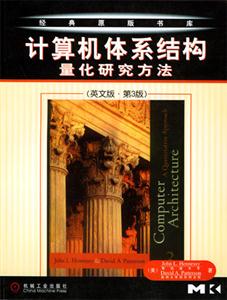-
>
全國計算機等級考試最新真考題庫模擬考場及詳解·二級MSOffice高級應用
-
>
決戰行測5000題(言語理解與表達)
-
>
軟件性能測試.分析與調優實踐之路
-
>
第一行代碼Android
-
>
JAVA持續交付
-
>
EXCEL最強教科書(完全版)(全彩印刷)
-
>
深度學習
計算機體系結構:量化研究方法:第3版 版權信息
- ISBN:711110921X
- 條形碼:9787111109211 ; 978-7-111-10921-1
- 裝幀:簡裝本
- 冊數:暫無
- 重量:暫無
- 所屬分類:>
計算機體系結構:量化研究方法:第3版 本書特色
The third edition of Computer Architecture: A Quantitative Approach should have been easy to write. After all, our quantitative approach hasn't changed, and we sought to continue our focus on the basic principles of computer design through two editions. The examples had to be updated, of course, just as we did for the second edition. The dramatic and ongoing advances in the field as well as the creation of new markets for computers and new approaches for those markets, however, led us to rewrite almost the entire book. The pace of innovation in computer architecture continued unabated in the six years since the second edition. As when we wrote the second edition, we found that numerous new concepts needed to be introduced, and other material designated as more basic. Although this is officially the third edition of Computer Architecture: A Quantitative Approach, it is really our fifth book in a series that began with the first edition, continued with Computer Organization and Design:The Hardware/Software Interface (COD:HSI), and then the second edition of both books. Over time ideas that were once found here have moved to COD:HSI or to background tutorials in the appendices. This migration, combined with our goal to present concepts in the context of the most recent computers, meant there was remarkably little from the second edition that could be preserved intact, and practically nothing is left from the first edition.
計算機體系結構:量化研究方法:第3版 內容簡介
The third edition of Computer Architecture: A Quantitative Approach should have been easy to write. After all, our quantitative approach hasn't changed, and we sought to continue our focus on the basic principles of computer design through two editions. The examples had to be updated, of course, just as we did for the second edition. The dramatic and ongoing advances in the field as well as the creation of new markets for computers and new approaches for those markets, however, led us to rewrite almost the entire book. The pace of innovation in computer architecture continued unabated in the six years since the second edition. As when we wrote the second edition, we found that numerous new concepts needed to be introduced, and other material designated as more basic. Although this is officially the third edition of Computer Architecture: A Quantitative Approach, it is really our fifth book in a series that began with the first edition, continued with Computer Organization and Design:The Hardware/Software Interface (COD:HSI), and then the second edition of both books. Over time ideas that were once found here have moved to COD:HSI or to background tutorials in the appendices. This migration, combined with our goal to present concepts in the context of the most recent computers, meant there was remarkably little from the second edition that could be preserved intact, and practically nothing is left from the first edition.
計算機體系結構:量化研究方法:第3版 目錄
1.1 Introduction
1.2 The Changing Face of Computing and the Task of the Computer Designer
1.3 Technology Trends
1.4 Cost, Price, and Their Trends
1.5 Measuring and Reporting Performance
1.6 Quantitative Principles of Computer Design
1.7 Putting It All Together: Performance and Price-Performance
1.8 Another View: Power Consumption and Efficiency as the Matric
1.9 Fallacies and Pitfalls
1.10 Concluding Remarks
1.11 Historical Perspective and References
Exercises
Chapter 2 InStruction Set Prindples and Examples
2.1 Introduction
2.2 Classifying Instruction Set Architectures
2.3 Memory Addressing
2.4 Addressing Modes for Signal Processing
2.5 Type and Size of Operands
2.6 Operands for Media and Signal Processing
2.7 Operations in the Instruction Set
2.8 Operations for Media and Signal Processing
2.9 Instructions for Control Flow
2.10 Encoding an Instruction Set
2.11 Crosscutting lssues:The Role of Compilers
2.12 Putting It All Together:The MIPS Architecture
2.1 3 Another View: The Trimedia TM32 CPU
2.14 Fallacies and Pitfalls
2.15 Concluding Remarks
2.16 Historical Perspective and References
Exercises
Chapter 3 Instruction-Level Parallelism and Its Dynamic Exploitation
3.1 Instruction-Level Parallelism:Concepts and Challenges
3.2 Overcoming Data Hazards with Dynamic Scheduling
3.3 Dynamic Scheduling: Examples and the Algorithm
3.4 Reducing Branch Costs with Dynamic Hardware Prediction
3.5 High-Performance Instruction Delivery
3.6 Taking Advantage of More ILP with Multiple Issue
3.7 Hardware-Based Speculation
3.8 Studies of the Limitations of ILP
3.9 Limitations on ILP for Realizable Processors
3.10 Putting It All Together: The P6 Microarchitecture
3.11 Another View: Thread-Level Parallelism
3.12 Crosscutting lssues: Using an ILP Data Path to Exploit TLP
3.13 Fallacies and Pitfalls
3.14 Concluding Remarks
3.15 Historical Perspective and References
Exercises
Chapter 4 Exploiting Instruction-Level Parallelism with Software Approaches
4.1 Basic Compiler Techniques for Exposing ILP
4.2 Static Branch Prediction
4.3 Static Multiple Issue: The VLIW Approach
4.4 Advanced Compiler Support for Exposing and Exploiting ILP
4.5 Hardware Support for Exposing More Parallelism at Compile Time
4.6 Crosscutting Issues: Hardware versus Software
Speculation Mechanisms
4.7 Putting It All Together:The Intel IA-64 Architecture and Itanium Processor
4.8 AnotherView: ILP in the Embedded and Mobile Markets
4.9 Fallacies and Pitfalls
4.10 Concluding Remarks
4.11 Historical Perspective and References
Exercises
Chapter 5 Memory Hierarchy Design
5.1 Introduction
5.2 Review of the ABCs of Caches
5.3 Cache Performance
5.4 Reducing Cache Miss Penalty
5.5 Reducing Miss Rate
5.6 Reducing Cache Miss Penalty or Miss Rate via Parallelism
5.7 Reducing Hit Time
5.8 Main Memory and Organizations for Improving Performance
5.9 Memory Technology
5.10 Virtual Memory
5.11 Protection and Examples of Virtual Memory
5.12 Crosscutting Issues: The Design of Memory Hierarchies
5.13 Putting It All Together: Alpha 21264 Memory Hierarchy
5.14 Another View: The Emotion Engine of the Sony Playstation 2
5.15 Another View: The Sun Fire 6800 Server
5.16 Fallacies and Pitfalls
5.17 Concluding Remarks
5.18 Historical Perspective and References
Exercises
Chapter 6 Multiprocessors and Thread-Level Parallelism
6.1 Introduction
6.2 Characteristics of Application Domains
6.3 Symmetric Shared-Memory Architectures
6.4 Performance of Symmetric Shared-Memory Multiprocessors
6.5 Distributed Shared-Memory Architectures
6.6 Performance of Distributed Shared-Memory Multiprocessors
6.7 Synchronization
6.8 Models of Memory Consistency: An Introduction
6.9 Multithreading: Exploiting Thread-Level Parallelism within a Processor
6.10 Crosscutting Issues
6.11 Putting It All Together: Sun's Wildfire Prototype
6.12 Another View Multithreading in a Commercial Server
6.13 Another View f Embedded Multiprocessors
6.14 Fallacies and Pitfalls
6.15 Concluding Remarks
6.16 Historical Perspective and References
Exercises
Chapter 7 Storage Systems
7.1 Introduction
7.2 Types of Storage Devices
7.3 Buses--Connecting I/O Devices to CPU/Memory
7.4 Reliability, Avai1ability, and Dependability
7.5 RAlD: Redundant Arrays of Inexpensive Disks
7.6 Errors and Failures in Real Systems
7.7 I/O Performance Measures
7.8 A Little Queuing Theory
7.9 Benchmarks of Storage Performance and Availability
7.10 Crosscutting Issues
7.11 Designing an I/O System in Five Easy Pieces
7.12 Putting It All Together: EMC Symmetrix and Celerra
7.13 Another View: Sanyo VPC-SX500 Digital Camera
7.14 Fallacies and Pitfalls
7.15 Concluding Remarks
7.16 Historical Perspective and References
Exercises
Chapter 8 Interconnection Networks and Clusters
8.1 Introduction
8.2 A Simple Network
8.3 Interconnection Network Media
8.4 Connecting More Than Two Computers
8.5 Network Topology
8.6 Practical Issues for Commercial Interconnection Networks
8.7 Examp1es of Interconnection Networks
8.8 Internetworking
8.9 Crosscutting Issues for Interconnection Networks
8.10 Clusters
8.11 Designing a C1uster
8.12 Putting It All Together: The Google Cluster of PCs
8.13 Another View: Inside a Cell Phone
8.14 Fallacies and Pitfalls
8.15 Concluding Remarks
8.16 Historical Perspective and References
Exercises
Appendix A Pipelining: Basic and Intermediate Concepts
A.1 Introduction
A.2 The Major Hurdle of Pipelining--Pipeline Hazards
A.3 How Is Pipelining Implemented?
A.4 What Makes Pipelining Hard to Implement?
A.5 Extending the MIPS Pipeline to Handle Multicycle Operations
A.6 Putting It All Together: The MIPS R4000 Pipeline
A.7 Another View: The MIPS R4300 Pipeline
A.8 Crosscutting Issues
A.9 Fallacies and Pitfalls
A.10 Concluding Remarks
A.11 Historical Perspective and References
Exercises
Appendix B Solutions to Selected Exercises
Introduction
B.1 Chapter 1 Solutions
B.2 Chapter 2 Solutions
B.3 Chapter 3 Solutions
B.4 Chapter 4 Solutions
B.5 Chapter 5 Solutions
B.6 Chapter 6 Solutions
B.7 Chapter 7 Solutions
B.8 Chapter 8 Solutions
B.9 Appendix A Solutions
Online Appendices (www.mkp.com/CA3/)
Appendix C A Survey of RISC Architectures for Desktop, Server,
and Embedded Computers
Appendix D An Alternative to RISC:The Intel 80X86
Appendix E Another Alternative to RISC:The VAX Architecture
Appendix F The IBM 360/370 Architecture for Mainframe Computer
Appendix G Vector Processors
Revised by Krste Asanovic
Appendix H Computer Arithmotic
by David Goldberg
Appendix I Implementing Coherence Protocols
References
Index
- >
煙與鏡
- >
大紅狗在馬戲團-大紅狗克里弗-助人
- >
伊索寓言-世界文學名著典藏-全譯本
- >
莉莉和章魚
- >
二體千字文
- >
小考拉的故事-套裝共3冊
- >
李白與唐代文化
- >
我與地壇















